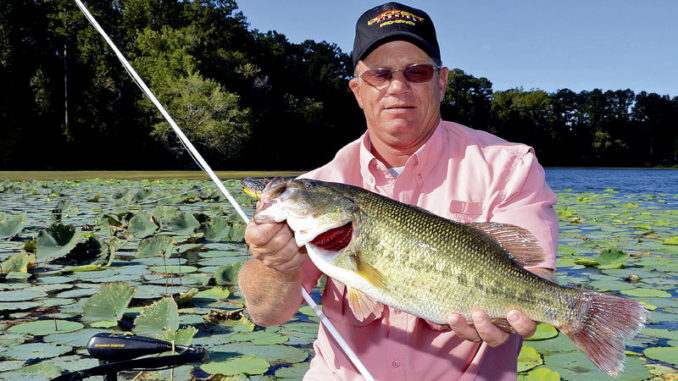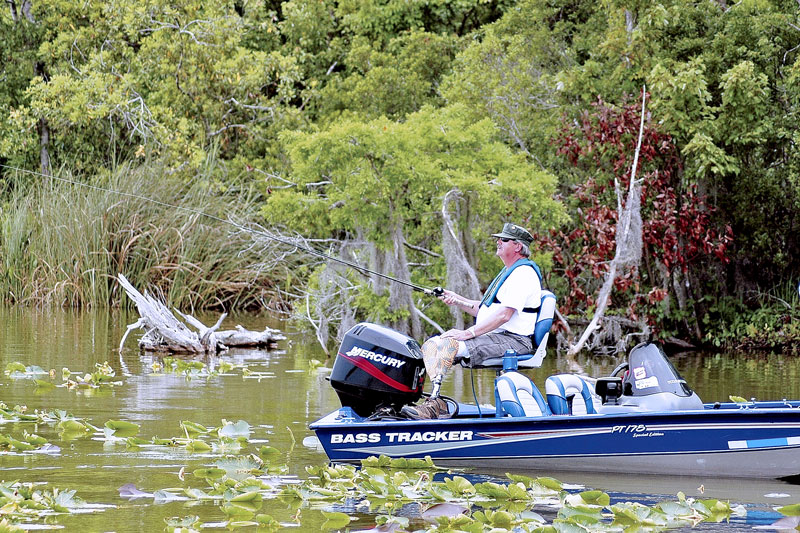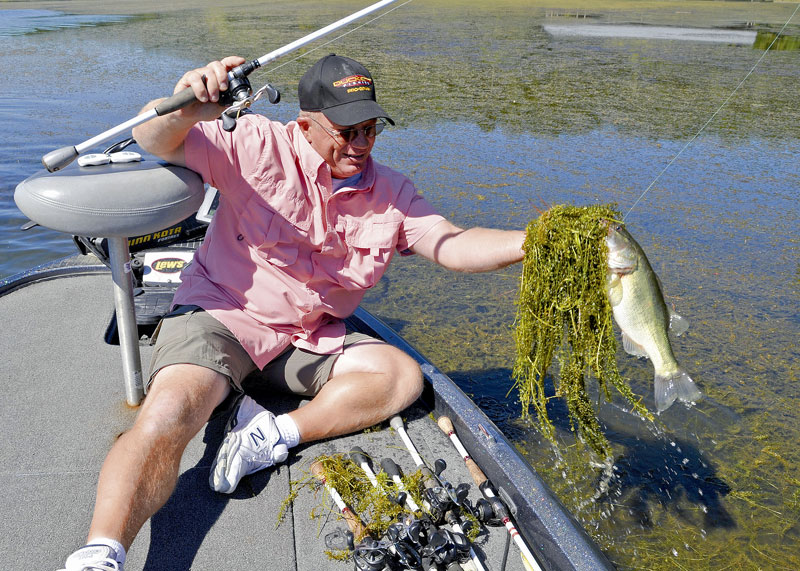
Matted vegetation is a common late-summer visitor to many bodies of water in Louisiana. It’s also a place where plenty of big bass live. Here’s how to get through the grass to the fish.
Looking more solid than watery, a thick mat of nearly impenetrable grass, lily pads or other vegetation dominated the surface of this marshy lagoon. We could barely tell where the dense, floating mats ended and what passed for a shoreline began.
Across the grass tops, a small, snake-like creature skittered over the surface. Moments later, the water erupted as if someone touched off an underwater charge. Engulfing the morsel — plus a load of floating grass — the pot-bellied green leviathan launched itself into the air as it crunched down on a fake salamander carrying a steel hook rather than the succulent meal it expected.
Vegetation gives bass everything they need: protective cover, added oxygen and a place where they can effectively ambush prey. To escape the broiling, late-summer sun, bass find cooling refuge under matted grass, lily pads, water hyacinths and other floating vegetation. Frequently, the biggest largemouths prowl the thickest weeds. In some especially robust areas, bass might grow old and fat without ever seeing a lure. Surrounded by the walls of their vegetative fortresses, monster bucketmouths might lose a bit of their wariness.
Abundant vegetation dominates many waters across Louisiana, particularly in the southern marsh country. Growing since early spring — perhaps longer after a mild winter — massive vegetative mats reach their densest growth by late summer before cool weather hits in the fall. By September, mats could choke off vast expanses of many waterways.
Copious mats can intimidate some anglers, but that’s where lunkers lurk. Anglers might pick around the edges with crankbaits, swim jigs, spinnerbaits or Texas-rigged worms, but to yank Mrs. Mossbacks from her vegetative lair, either go over the tops of mats or punch through them.


Doing the surface dance
Nothing dances over such entangling salad quite as impressively as a buzz frog. Frogs combine attributes of thrilling topwater action, the fish-finding abilities of buzzbaits and the weedless enticement of Texas-rigged soft plastics. Churning over aquatic foliage, they create lifelike silhouettes that bass would expect to hunt in such habitat.
“Throwing a frog is a tremendous way to fish grass,” said Shaw Grigsby, a professional bass angler from Gainesville, Fla. “A buzz frog is one of the few lures that anglers can use in really thick, matted vegetation all-year long. It’s a very simple bait to use, but it’s a bait that can produce big fish. I can’t tell how many big bass I’ve caught on buzz frogs, including some weighing more than 9 pounds. Bass come out from under the lily pads or grass beds to eat it. When a big bass explodes on a frog, there’s nothing more exciting.”
Rigged weightless with a 3/0 to 5/0 wide-gap hook inserted into the body or with upturned hooks, soft-plastic frogs can go virtually anywhere with relative ease, tempting hungry bass waiting under weedy canopies. When fishing such entangling cover, use braided line, perhaps 65- to 80-pound test. Anglers need backbone to horse in a lunker largemouth plus a wad of accumulated vegetation when fishing thick mats.

“When I’m fishing a buzz frog, I use a screw-lock hook to screw the hook into the bait to hold it securely,” Grigsby said. “I fish it on braided line. Braid not only helps with the hookset, but it actually helps cut through the vegetation and lily pads so we can land the fish.”
Some frogs float, and others sink. Pull either kind steadily across mat tops. With their kicking legs, buzz frogs generate substantial vibrations. Also try the “hop-and-stop” method. Jerk the rod so the frog jumps a couple feet, like live prey might. Then pause. Let floating frogs sit on the surface a few moments. In pockets, allow sinkers to drop a bit before resuming the retrieve.
“A buzz frog is like a buzzbait that anyone can throw in the thickest vegetation where a regular buzzbait would hang up on every cast,” Grigsby said. “It comes through cover easily. The legs on a buzz frog sputter like a buzzbait. Anytime it hits a pocket of clear water, it makes quite a commotion. My favorite way is to throw it out weightless and just reel it across the lily pads or grass. Even on a steady retrieve, I twitch it a bit just to give it a little different sound.”
When a big bass detonates on a frog, resist the temptation to set the hook too quickly. Lower the rod and pause for a moment to feel for the fish on the line. If a bass blows up, but misses the frog, stop reeling. Let the frog sink or twitch it in place a few seconds as if it’s wounded. Bass often return to finish off crippled prey.
“The hardest thing about fishing frogs is not reacting to a strike immediately,” said Terry Segraves, another bass pro from Florida. “Give the fish a split-second to get the bait in its mouth before setting the hook.”
Buzz frogs create significant surface commotion, but sometimes, bass want something more subtle. On calm mornings, throw a weightless, soft-plastic salamander, jerkbait, Fluke or similar creature. Some very light baits might require extra casting heft, especially on windy days, so attach a split-shot to the line. Use just enough weight to permit good casting. Insert the hook into the plastic, just like a frog. Some baits come with belly slots into which you can insert hooks and hide the points.
“In thick, matted grass, nothing works better than a weightless, soft-plastic jerkbait,” Segraves said. “I use it weedless with a 4/0 or 5/0 hook. I work it over the grass tops just like a topwater bait. It’s unbelievable some of the explosions we see. Bass just come after them right up through the grass. That’s pretty exciting.”
Work slithering soft plastics much slower than buzz frogs. Using the reel only to take up slack line, move the bait in short spurts with the rod so it flits from clump to clump. In open pockets, let the bait sink like a wacky worm. Bass habitually slurp subtle offerings as they sink.

Breaking through
Matted grass looks imposingly solid on the surface, and the canopy blocks sunlight, cooling the water and killing any submerged vegetation beneath it. Regularly, bass hang just under the mats in the shade. With a long rod, swing Texas-rigged tubes, worms or weedless jigs toward tiny, open pockets. Chunky tubes resemble squid and create bigger silhouettes than worms, but easily slip through the densest cover. A skilled angler can stop the bait in the air at the last second so it enters the tiniest pocket with pinpoint accuracy and hardly a ripple. Let the bait descend naturally. After it hits bottom, jig it up a couple times. If nothing strikes, flip the bait into another nearby opening.
“I try to make the tube enter the water as lightly as possible to avoid spooking bass,” said Dean Rojas, a veteran bass pro from Arizona. “Tungsten is a heavier material than lead, so it provides better penetration in a smaller package. Point the rod tip toward cover as the tube goes out. As it lands, pick up the rod tip to make a soft entry. I let a tube fall to the bottom and hop it once or twice. A tube looks like a dying shad as it falls, but resembles a crawfish when it hits bottom. Most often, fish hit on the fall or the second bounce.”
When subtlety doesn’t work, try something more dynamic. Cast a 1- to 3-ounce jighead into the air so it crashes down like a meteor smashing through the roof. This sudden invasion of its lair can provoke vicious reaction strikes from bass.
“I fish the grassy edges to catch the aggressive bass,” said Mike Wurm, a professional bass angler from Arkansas. “Then, I break through the grass with a heavy jig and fish right in the middle of it to get down to them. It’s difficult to get a heavy jig through the grass, but that’s where fish live.”

Other options
Other baits can also work around grass beds. Dropping wacky worms next to grassy edges can entice strikes. Spinnerbaits and buzzbaits can go over or through patchy grass and open seams. Not entirely weedless, willow-leaf blades cut through grass better than other shapes. Hardly used any longer, weedless spoons sweetened with frog-like trailers can still incite brutal strikes. Pull a spoon over grass tops like a frog or wobble it enticingly parallel to the edges. In openings, let the spoon sink so it flutters down like a dying shad.
“Canopy cover” can also take other forms, such as trees overhanging a bayou, bridges, moored boats, docks, platforms and anything else that shades the water. During late summer’s swelter, anything that cools water might attract bass. Water just a degree or two cooler could make a huge difference to fish.
In Louisiana, people fish grass all-year long, mainly by necessity, but also because some bass stay in the thickest vegetation their entire lives. An almost solid, grassy blanket could dissuade anglers, but those mats also conceal lunkers that many other anglers won’t even attempt to catch.


